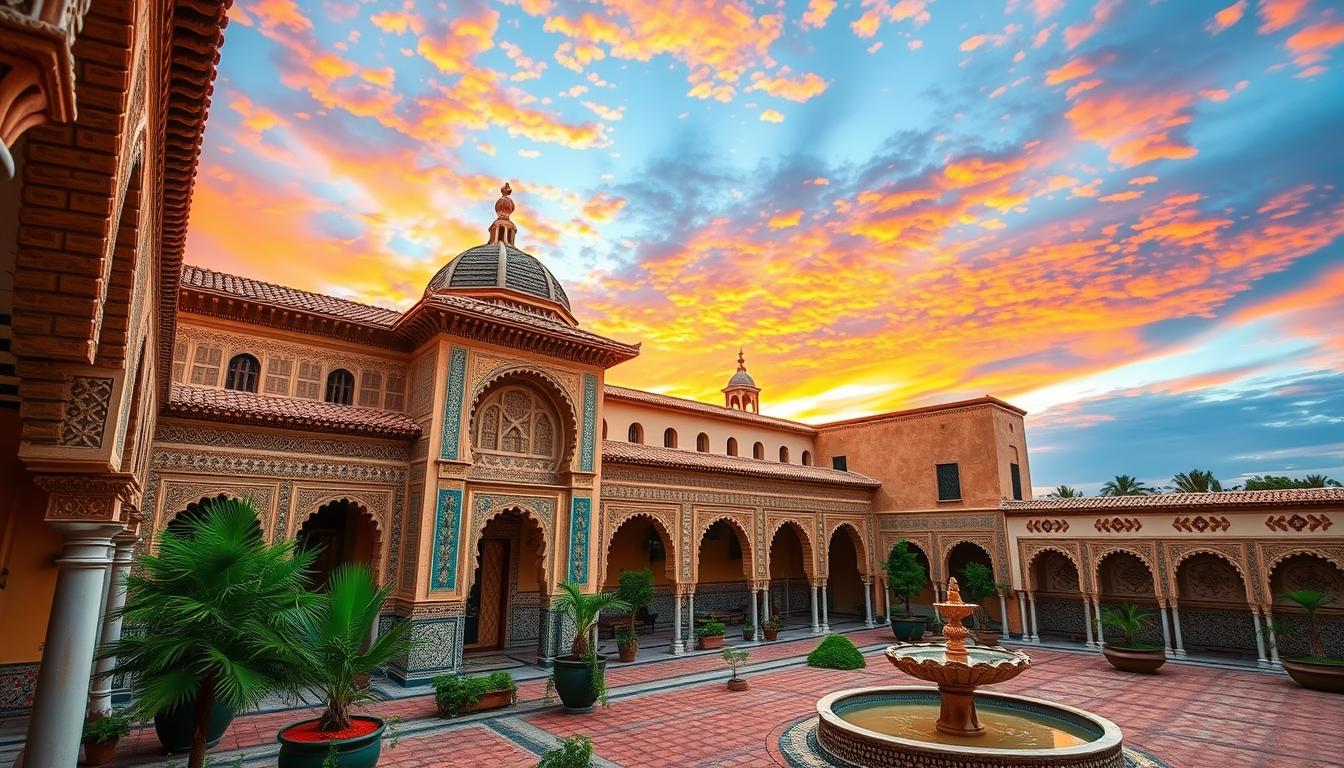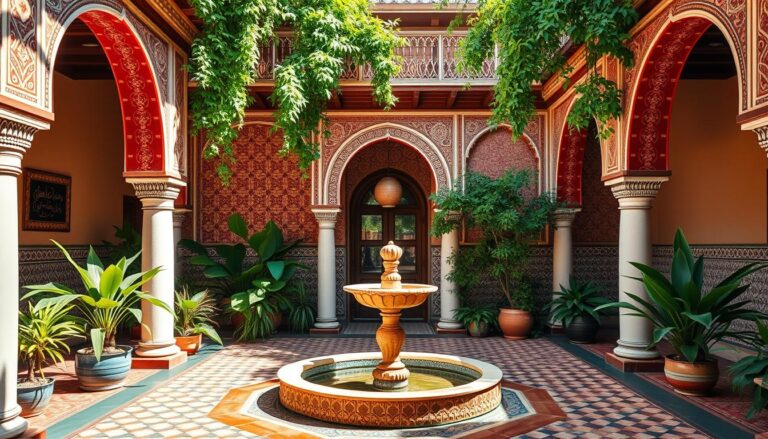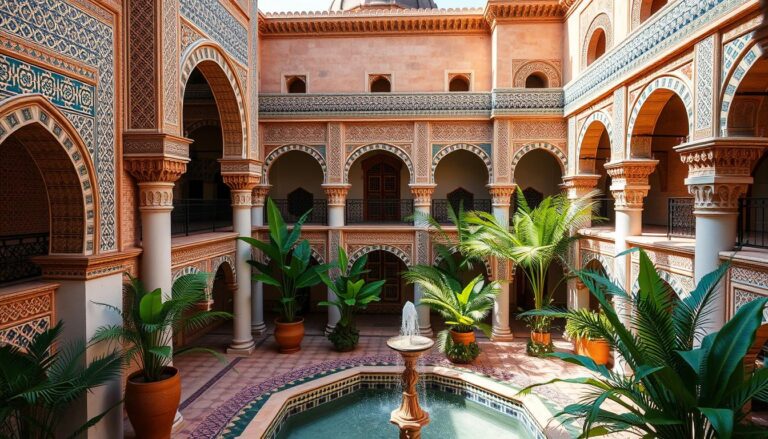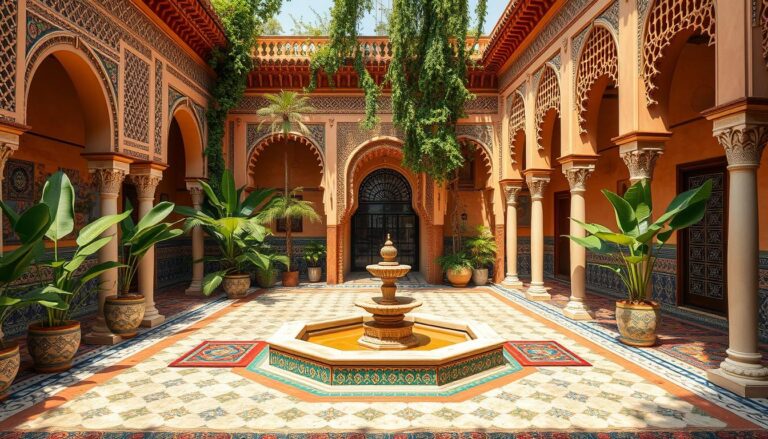Moroccan architecture shows the area’s rich cultural mix. It combines North Africa’s Amazigh (Berber) traditions, pre-Islamic Spain, and Islamic Middle East’s art. Over time, it has developed a unique style. This style is known for the horseshoe arch, riad gardens, and detailed geometric and arabesque designs.
But what makes Moroccan architecture truly special? How have Middle Eastern influences shaped its identity? Exploring Moroccan design, we’ll discover its origins, influences, and sustainable aspects. These have made its architecture both captivating and lasting.
Key Takeaways
- Moroccan architecture is a blend of Amazigh (Berber) culture, pre-Islamic Spanish influences, and Islamic Middle East’s art.
- Its unique features include the horseshoe arch, riad gardens, and intricate geometric and arabesque designs.
- In the Middle East, architects seek “identity” in their work. Terms like “originality,” “locality,” and “globalism” are common in discussions.
- Researchers in Arabic-speaking areas focus on passive design and local building methods. Mainstream efforts combine traditional elements with modern designs.
- More research is needed to help designers and architects showcase Islamic cities like Moroccan architecture at their best.
The Origins of Moroccan Islamic Architecture
Islam arrived in Morocco in the 8th century, changing the country’s architecture forever. Islamic values influenced the buildings and their designs. The al-Qarawiyyin and Andalusiyyin mosques in Fes are examples, showing the “Moorish” arch.
These mosques were inspired by the Great Mosque of Kairouan and the Great Mosque of Cordoba. They reflect the beauty and spirituality of Islamic architecture.
Influences from the Middle East and Andalusia
In the 10th century, northern Morocco was influenced by the Umayyad Caliphate of Cordoba. This led to big changes in the Qarawiyyin and Andalusiyyin mosques. Architectural ideas from the Middle East and Andalusia merged, shaping Moorish architecture, western Islamic architecture, and Amazigh architecture.
The Arrival of Islam and Early Mosques
- The first mosques in Morocco, like the al-Qarawiyyin and Andalusiyyin in Fes, were built in the hypostyle form. This style uses columns to support a prayer hall.
- These mosques used the distinctive horseshoe or “Moorish” arch. This design became a key feature of Almoravid architecture and Almohad architecture.
- The arrival of Islam and the building of these mosques started a unique Moroccan architectural style. It combined Moorish architecture and western Islamic architecture.
“The early Islamic-era monuments in Morocco, such as the al-Qarawiyyin and Andalusiyyin mosques in Fes, were built in the hypostyle form and made early use of the horseshoe or ‘Moorish’ arch, reflecting influences from major monuments like the Great Mosque of Kairouan and the Great Mosque of Cordoba.”
The Berber Empires: Almoravids and Almohads
The fall of the Cordoban caliphate in the early 11th century opened the door for the rise of the Almoravids (11th-12th centuries) and Almohads (12th-13th centuries) in Morocco. This time was key in the history of Moroccan and Moorish architecture. It set the stage for many architectural forms and motifs that would evolve over the centuries.
Architectural Achievements and Innovations
The Almoravids took architectural ideas from al-Andalus and added new designs from the east, like muqarnas. The Almohads, meanwhile, built a new capital at Marrakesh and started work on a grand capital in Rabat. The Kutubiyya and Tinmal mosques are seen as the start of later Moroccan mosques. They also created garden estates around their capital.
“The Almohad dominance in the Islamic West reflected the influence of the Andalusian cultural legacy.”
Recent digs have uncovered important details about the Almoravid and Almohad buildings. These discoveries show how these Berber empires shaped Moroccan Moorish architecture. They drew inspiration from Andalusian and eastern styles.
The Almoravids and Almohads’ architectural innovations set the stage for Moroccan architecture‘s growth. Their work laid the groundwork for future developments. This rich heritage still fascinates scholars and tourists, offering a peek into Morocco’s cultural and architectural past.
The Marinid Dynasty
The Marinid dynasty ruled from the 13th to the 15th century. They built on the traditions of the Almoravids and Almohads. Their architecture became a key part of Moroccan and Moorish styles.
The Marinids supported education a lot. They built many madrasas (Islamic schools) across Morocco. These schools were not just for learning but also showed off the Marinid’s love for Moroccan Islamic heritage.
The Madrasa Bou Inania in Fez is a standout example. Built between 1350 and 1355, it was for Sultan Abu Inan Faris. It’s the only madrasa in Fez with a minaret, showing the Marinid’s architectural prowess.
“The Marinids in the 13th-15th centuries continued the architectural traditions set by the Almoravids and Almohads, influencing subsequent styles in Morocco.”
The Marinids also changed the look of Moroccan cities. They built fortifications, palaces, and public buildings. These projects helped make Moroccan architecture unique during their time.
The Marinid dynasty’s impact on Moroccan architecture is huge. Their work shows their dedication to preserving and growing the region’s cultural heritage. Today, people all over the world study and admire their architectural legacy.
Sustainable Features of Vernacular Architecture
The hot-arid regions of North Africa, like the Ksours and Kasbahs in Morocco, are known for their vernacular architecture. They create their own microclimates and control the climate passively. The Kasbahs’ layout, with small windows and thick walls, helps manage temperature and air flow.
The Arabic courtyard house also uses a central atrium and shading devices like the mashrabiya. These features help cool the space naturally. Traditional Moroccan architecture teaches us about sustainable design, especially in the face of climate change.
The Ksours and Kasbahs of Morocco
Studies on the Mdagra oasis in northern Morocco show the sustainable design of ksours and kasbahs. Researchers looked at 53 ksour over 29 km by 2 km. They found these designs are well-suited to the local climate.
Arabic Courtyard Houses and Climate Control
The courtyard house design in Arabic architecture is a great example of passive cooling. The central atrium and mashrabiya create a cool microclimate. This design offers insights for modern, sustainable buildings.
“Sustainability in architecture involves meeting environmental, social, and functional demands.”
Modernization and westernization threaten these architectural wonders. It’s important to learn from Morocco’s sustainable design and apply it to today’s buildings.
Middle Eastern adaptations in Moroccan Architecture
Moroccan architecture has been shaped by the Middle East’s rich culture and art. This mix of influences has created the unique style seen in Moroccan buildings. Features like horseshoe arches and intricate designs are common.
The Middle East’s design elements are a big part of Moroccan architecture. Influences from Andalusia, Spain and Portugal, also play a big role. This blending has made Moroccan architecture special, combining Middle Eastern, Islamic, and Berber styles.
Features like the riad and the use of materials like terra-cotta show this mix. Moroccan architects have made these designs fit the local climate and environment. This has led to a vibrant, responsive architecture.
The mix of Middle Eastern adaptations, cultural integration, and regional influences has shaped Moroccan architecture. It has created a space that honors its heritage while meeting Moroccan needs.
The Windcatchers of Yazd
The historic city of Yazd in Iran is famous for its windcatchers. These tall towers catch cool breezes and send them into buildings. This natural method helps beat the heat in the dry climate.
Traditional Iranian Architecture for Hot Climates
The windcatchers of Yazd show off Iran’s smart vernacular architecture. These Badgirs are built to catch the wind and cool buildings naturally. This cuts down on the need for air conditioning.
The height and design of the windcatchers matter a lot. Taller ones catch stronger winds. The shape of the opening also helps improve airflow. Plus, they often work with other cooling systems for better results.
“The windcatchers of Yazd are just one example of the ingenious traditional Iranian architecture that has evolved to address the challenges of hot, dry environments, offering valuable lessons and inspiration for sustainable design and climate-responsive architecture.”
The windcatchers of Yazd highlight Iran’s long history of building for comfort in harsh weather. These vernacular architecture ideas are still useful today. They inspire architects to create cooler buildings in hot places.
The Genius of Moroccan Architecture
Moroccan architecture is a blend of old and new. It shows how well it can adapt to local conditions. This is thanks to the mix of cultures and environments in the region.
The Kasbahs and courtyard houses are known for their detailed designs and smart climate control. The Berber empires also left a mark with their grand buildings. Moroccan architecture is a leader in sustainable design and climate-responsive ideas.
These designs are crucial as we face climate change. They show us how to build for the future. Moroccan vernacular architecture is full of lessons for us all.
The Ksours and Kasbahs of Morocco are a great example of this genius. They use mud bricks and rammed earth to keep cool in the desert heat. Windows and thick walls help control the temperature inside.
“The expertise in traditional building techniques is becoming scarce, with only few elderly individuals retaining the knowledge.”
New homes in Morocco are now made of concrete, not traditional materials. This is a big loss for the architectural innovation of the region. But, there are efforts to save and teach the old ways.
Moroccan architecture is a source of inspiration for solving sustainability and climate change issues. It shows us how to design buildings that work with the environment. By learning from the past, we can build a better, more sustainable future.
Conclusion
Moroccan architecture shows the region’s rich culture and the skill of its creators. It spans from early Islamic buildings to the modern Ksours and Kasbahs. These structures mix Middle Eastern styles with local needs, making them unique.
Today, as we face climate change, Moroccan architecture teaches us important lessons. Its focus on sustainability and adapting to the environment is crucial. By learning from Moroccan architecture, we can tackle modern environmental and design challenges.
Moroccan architecture is a blend of cultures and creativity. It includes everything from grand mosques to eco-friendly homes. This mix of Middle Eastern and local styles is a model for sustainable building in our changing world.
Source Links
- Architecture with Identity Crisis: The Lost Heritage of the Middle East
- Andalusian and Maghrebi Art and Architecture | Islamic Art and Architecture Class Notes | Fiveable
- The Islamic art and design elements applied in the Islamic city – City, Territory and Architecture
- Islamic architecture
- Islamic arts – Middle East, Architecture, Calligraphy | Britannica
- The Great Reform Empires (1100–1250 CE)
- Andalusi Spolia in Medieval Morocco: ‘Architectural Politics, Political Architecture’
- Moroccan architecture
- The Madrasa, an Ancestral Architectural Jewel of Marinid Morocco – The Moorish Times
- Sustainable Features of Vernacular Architecture – A Case Study of Climatic Controls in Hot Arid Climate
- Tradition and Sustainability in Vernacular Architecture of Southeast Morocco
- Microsoft Word – Vernacular informs Sustainanle.doc
- Windcatcher
- The Rise and Evolution of Wind Tower Designs in Egypt and the Middle East
- How Moroccan Architecture Is Built to Beat the Heat – Journey Beyond Travel
- hesperis tome 2 okk.indd
- Architectural Wonders of Morocco – Rahtours
- Unlocking the Timeless Allure of Moroccan Architecture

The Editorial Team is a passionate group of Morocco enthusiasts dedicated to sharing the beauty, culture, and wonders of this captivating country. With diverse backgrounds and a deep love for travel, we strive to bring you engaging and informative content that inspires your Moroccan adventures. From uncovering hidden gems and sharing local insights to exploring mouthwatering cuisine and showcasing the vibrant lifestyle, our team is committed to providing you with valuable resources and exciting stories that enhance your exploration of Morocco. Join us on this journey as we celebrate the rich heritage and unforgettable experiences that make Morocco truly special.







